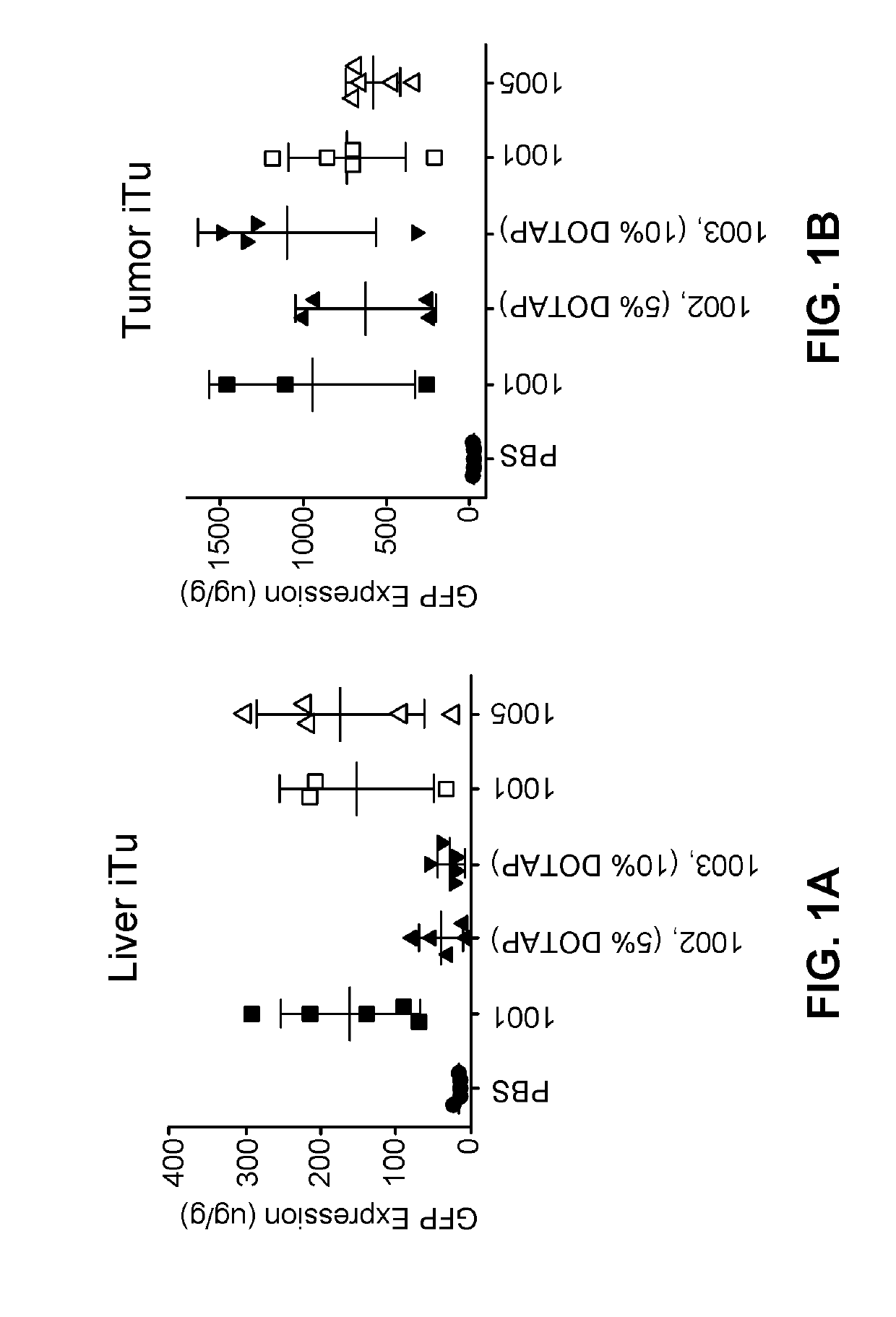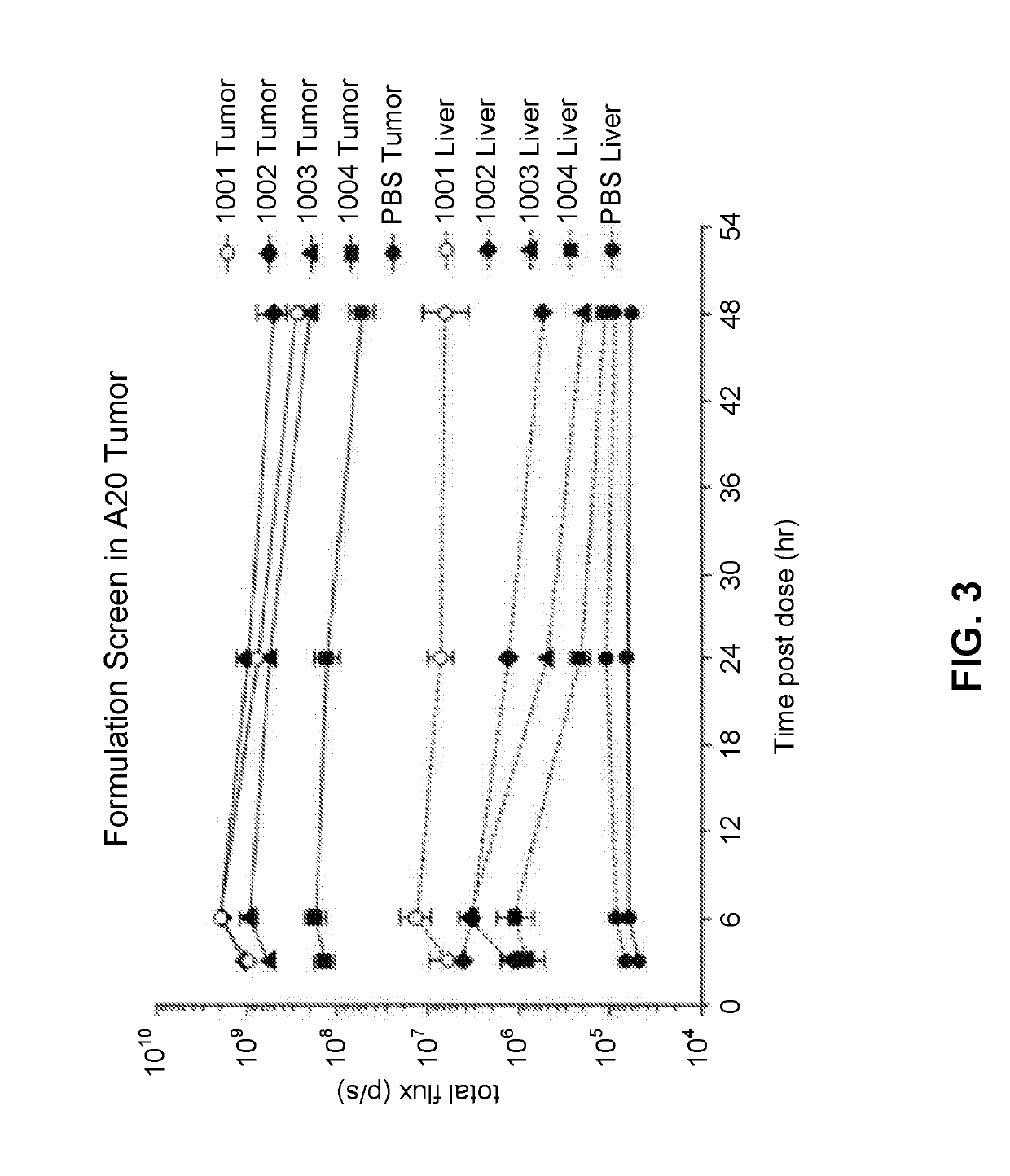Lipid compositions and their uses for intratumoral polynucleotide delivery
a technology of lipid compositions and polynucleotides, applied in the direction of drug compositions, non-active ingredients of oil/fat/waxes, genetic material ingredients, etc., can solve the problems of limited success in delivering a therapeutic agent to target tissues specifically and efficiently, lack of stability, specificity, low activity,
- Summary
- Abstract
- Description
- Claims
- Application Information
AI Technical Summary
Benefits of technology
Problems solved by technology
Method used
Image
Examples
example 1
Synthesis of Compounds According to Formula (I)
A. General Considerations
[1299]All solvents and reagents used were obtained commercially and used as such unless noted otherwise. 1H NMR spectra were recorded in CDCl3, at 300 K using a Bruker Ultrashield 300 MHz instrument. Chemical shifts are reported as parts per million (ppm) relative to TMS (0.00) for 1H. Silica gel chromatographies were performed on ISCO CombiFlash Rf+ Lumen Instruments using ISCO RediSep Rf Gold Flash Cartridges (particle size: 20-40 microns). Reverse phase chromatographies were performed on ISCO CombiFlash Rf+ Lumen Instruments using RediSep Rf Gold C18 High Performance columns. All final compounds were determined to be greater than 85% pure via analysis by reverse phase UPLC-MS (retention times, RT, in minutes) using Waters Acquity UPLC instrument with DAD and ELSD and a ZORBAX Rapid Resolution High Definition (RRHD) SB-C18 LC column, 2.1 mm, 50 mm, 1.8 μm, and a gradient of 65 to 100% acetonitrile in water wit...
example 2
Characterization of Nanoparticle Compositions
[1343]A Zetasizer Nano ZS (Malvern Instruments Ltd, Malvern, Worcestershire, UK) can be used to determine the particle size, the polydispersity index (PDI) and the zeta potential of the nanoparticle compositions in 1× PBS in determining particle size and 15 mM PBS in determining zeta potential.
[1344]Ultraviolet-visible spectroscopy can be used to determine the concentration of a polynucleotide (e.g., RNA) in nanoparticle compositions. 100 μL of the diluted formulation in 1× PBS is added to 900 μL of a 4:1 (v / v) mixture of methanol and chloroform. After mixing, the absorbance spectrum of the solution is recorded, for example, between 230 nm and 330 nm on a DU 800 spectrophotometer (Beckman Coulter, Beckman Coulter, Inc., Brea, Calif.). The concentration of polynucleotide in the nanoparticle composition can be calculated based on the extinction coefficient of the polynucleotide used in the composition and on the difference between the absor...
example 3
Lipid Nanoparticle Formulations Containing Green Fluorescent Protein (GFP) Gene
[1347]The following lipid nanoparticle formulations containing GFP gene were prepared according to the following table. The method of preparing the formulations is analogous to those disclosed in U.S. Patent Application Publication No. 2013 / 0245107, Example 9.
For-Lipids (Mole %)mu-Ionizable QuaternarylationPhos-aminoamineID #pholipidSterollipidcompoundPEG-Lipid100110% DSPC38.5% CHOL50% MC3N / A1.5% PEG2k-DMG100210% DSPC33.5% CHOL50% MC3DOTAP1.5% PEG2k-(5%)DMG100310% DSPC28.5% CHOL50% MC3DOTAP1.5% PEG2k-(10%)DMG100410% DSPC18.5% CHOL50% MC3DOTAP1.5% PEG2k-(20%)DMG100510% DSPC38.5% CHOL50% L608N / A1.5% PEG2k-DMG1006N / A48.5% CHOL50% MC3N / A1.5% PEG2k-DMG100710% SMPC38.5% CHOL50% MC3N / A1.5% PEG2k-DMG100810% DPPC38.5% CHOL50% MC3N / A1.5% PEG2k-DMG100910% PLPC38.5% CHOL50% MC3N / A1.5% PEG2k-DMG101010% POPC38.5% CHOL50% MC3N / A1.5% PEG2k-DMG101110% MSPC38.5% CHOL50% MC3N / A1.5% PEG2k-DMG101210% PMPC38.5% CHOL50% MC3N / A1...
PUM
| Property | Measurement | Unit |
|---|---|---|
| Fraction | aaaaa | aaaaa |
| Fraction | aaaaa | aaaaa |
| Fraction | aaaaa | aaaaa |
Abstract
Description
Claims
Application Information
 Login to View More
Login to View More - R&D
- Intellectual Property
- Life Sciences
- Materials
- Tech Scout
- Unparalleled Data Quality
- Higher Quality Content
- 60% Fewer Hallucinations
Browse by: Latest US Patents, China's latest patents, Technical Efficacy Thesaurus, Application Domain, Technology Topic, Popular Technical Reports.
© 2025 PatSnap. All rights reserved.Legal|Privacy policy|Modern Slavery Act Transparency Statement|Sitemap|About US| Contact US: help@patsnap.com



